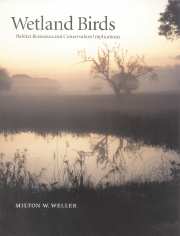Book contents
- Frontmatter
- Contents
- List of plates
- Preface
- Acknowledgments
- 1 Introduction
- 2 Wetlands: what, where, and why
- 3 Major groups of birds that use wetlands
- 4 Water and other resource influences
- 5 Foods, feeding tactics, strategies, and guilds
- 6 Bird mobility and wetland predictability
- 7 Other behavioral and physical influences on wetland living
- 8 Spatial and structural patterns
- 9 Habitat dynamics: water, plant succession, and time
- 10 Population consequences of wetland abundance and quality
- 11 How birds influence wetlands
- 12 Conservation implications
- 13 Measures of bird habitat use and quality
- 14 Current status and some conservation problems
- 15 Conservation and management strategies
- 16 Outlook
- 17 Epilogue
- Appendix 1 Scientific names of birds and bird groups
- Appendix 2 Scientific names of animals and animal groups other than birds
- Appendix 3 Scientific names of plants and plant groups
- Index of birds and bird groups
- Subject index
17 - Epilogue
Published online by Cambridge University Press: 02 October 2009
- Frontmatter
- Contents
- List of plates
- Preface
- Acknowledgments
- 1 Introduction
- 2 Wetlands: what, where, and why
- 3 Major groups of birds that use wetlands
- 4 Water and other resource influences
- 5 Foods, feeding tactics, strategies, and guilds
- 6 Bird mobility and wetland predictability
- 7 Other behavioral and physical influences on wetland living
- 8 Spatial and structural patterns
- 9 Habitat dynamics: water, plant succession, and time
- 10 Population consequences of wetland abundance and quality
- 11 How birds influence wetlands
- 12 Conservation implications
- 13 Measures of bird habitat use and quality
- 14 Current status and some conservation problems
- 15 Conservation and management strategies
- 16 Outlook
- 17 Epilogue
- Appendix 1 Scientific names of birds and bird groups
- Appendix 2 Scientific names of animals and animal groups other than birds
- Appendix 3 Scientific names of plants and plant groups
- Index of birds and bird groups
- Subject index
Summary
Wetlands are exciting places for many reasons, but birds are among the more prominent attractions. Birds are perhaps the most conspicuous component of a diverse biotic community with complex physical drivers interwoven in an ecosystem that is both unique and important. Wetlands have played an important role in supplying the resources needed for many societies and still function in that way for some groups today, but they also have provided an ideal setting for developing the scientific understanding of how such complex ecological systems function. But many wetlands are in jeopardy, and birds will be among the first indicators of dangers ahead for an individual wetland or for a wetland type or region. Despite the amazing resilience of many wetland types (which we can and do exploit to our benefit), others are delicate and probably irreplaceable. Moreover, they are sensitive to seemingly unrelated events both inside and outside the system that can change so much and so fast, and often to the detriment of waterbirds. Few habitats demonstrate the importance of one major driver, water, on the complexity, organization, and dynamics of an ecosystem. Although all habitats respond to water, wetlands have short-term and long-term consequences that dictate the biodiversity and trophic structure of the entire community – sometimes for hundreds of years – through plant and animal succession. Although temperature can also be very important, it is always secondary to the availability and timing of water.
It should be clear by now that habitat and its diverse resources determine in many direct and indirect ways the evolution of individual species and the relationships between species of a community.
- Type
- Chapter
- Information
- Wetland BirdsHabitat Resources and Conservation Implications, pp. 245 - 248Publisher: Cambridge University PressPrint publication year: 1999
- 1
- Cited by



